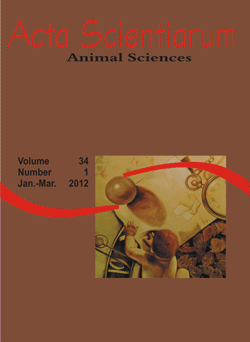<b>Dynamics of nitrogen concentration on intercropped ryegrass</b> - 10.4025/actascianimsci.v34i1.12661
Abstract
The dynamics of nitrogen (N) in ryegrass intercropped with different forage species with regard to dry matter (DM) accumulation within an agroecological transition system was evaluated. Annual ryegrass was intercropped with black oats (RY + BO), white clover (RY + WC) and forage peanut (RY + FP). The experimental design was completely randomized, with three replications. The study applied the N dilution model for plant tissue which comparatively uses modifiable factors of the environment at optimal levels. The model shows decline in N concentration due to the DM accumulation of temperate grass pastures. Data were compared to model by the root mean square deviation analysis. Dilution coefficient (β), used in all pasture samples, was lower than -0.60. Highest N concentration decline in plant tissues, due to DM accumulation, occurred in RY + WC pastures (β = -0.94), followed by RY + FP (β = - 0.86) and RY + BO (β = - 0.67), respectively. Ryegrass intercropped with white clover showed the highest N content in plant tissue, with a nitrogen nutrition index close to the proposed model.Downloads
Download data is not yet available.
Published
2011-09-22
How to Cite
Skonieski, F. R., Viégas, J., Cruz, P., Nornberg, J. L., Bermudes, R. F., & Gabbi, A. M. (2011). <b>Dynamics of nitrogen concentration on intercropped ryegrass</b> - 10.4025/actascianimsci.v34i1.12661. Acta Scientiarum. Animal Sciences, 34(1), 1-6. https://doi.org/10.4025/actascianimsci.v34i1.12661
Issue
Section
Pasture and forage utilization
DECLARATION OF ORIGINALITY AND COPYRIGHTS
- I Declare that current article is original and has not been submitted for publication, in part or in whole, to any other national or international journal.
The copyrights belong exclusively to the authors. Published content is licensed under Creative Commons Attribution 4.0 (CC BY 4.0) guidelines, which allows sharing (copy and distribution of the material in any medium or format) and adaptation (remix, transform, and build upon the material) for any purpose, even commercially, under the terms of attribution.
Read this link for further information on how to use CC BY 4.0 properly.
0.9
2019CiteScore
29th percentile
Powered by 








































